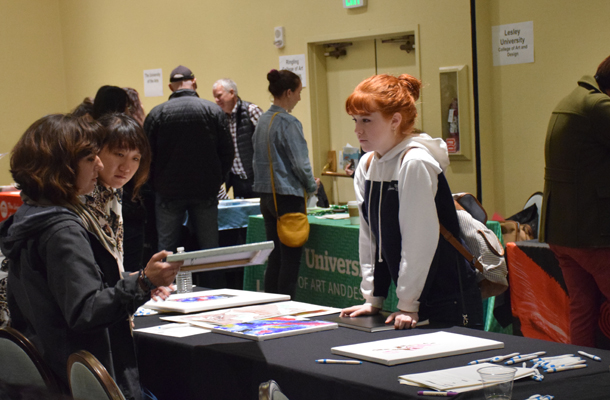Art Schools Offer Portfolio Feedback
January 17, 2017
This year’s National Portfolio Day attracted crowds of high-schoolers wanting constructive criticism on their artwork at Sheraton Fisherman’s Wharf Hotel on January 14. It’s a yearly event that encourages young artists to show their work to professors of various colleges.
Almost 40 colleges from all across the US participated, including Parsons School of Design and Rhode Island School of Design, which are among the top 5 best art and design colleges in the US according to the Top Universities website.
Junior Hannah Eberhardt said, “It’s important to attend to get multiple opinions of your work and to see what you need to do to get into art school.”
Students were informed about this event by art teacher Jill Langston. She attended the event with her daughter Ivy Langston, who presented her own artwork to different colleges.
The event was hosted by San Francisco Art Institute, which gathered many professors willing to give feedback. Among them was Christopher Coppola, of the Coppola family.
Coppola said, “I’m always fascinated by what I see [during the event] ‘cause there’s a need to share ideas and a need for generations to talk, and art is one of the best ways to do that.”
Underclassmen had to wait behind long lines of Seniors who were eager to receive feedback.
Eberhardt managed to get 2 colleges to critique her work. “I was able to get feedback on my work and am now able to put together a better portfolio because of it,” she said.
Coppola sees 2 ways this event is helpful for young artists. “It gives young people a chance to know the taste of what it’s like to show your work and get feedback, and see both how difficult it is and also how wonderful the possibilities are. It can be encouraging, but at the same time, it can also be discouraging. It’s also good for us older people to see what younger generations are trying to communicate, and it’s great when someone who has been with that sort-of skill set a while longer can share some of their knowledge to young people,” he explained.
Many high-schoolers think of art colleges as a risky choice because careers in the art field are difficult to find, and may not offer financial security. “Out of the 2 million art graduates in the nation, only 200,000, or 10 percent, earn their living primarily as artists,” reports The Atlantic website.
Coppola said, “I think it’s important that art is part of our daily lives, so we need it in the future. We need to keep young people going.”
